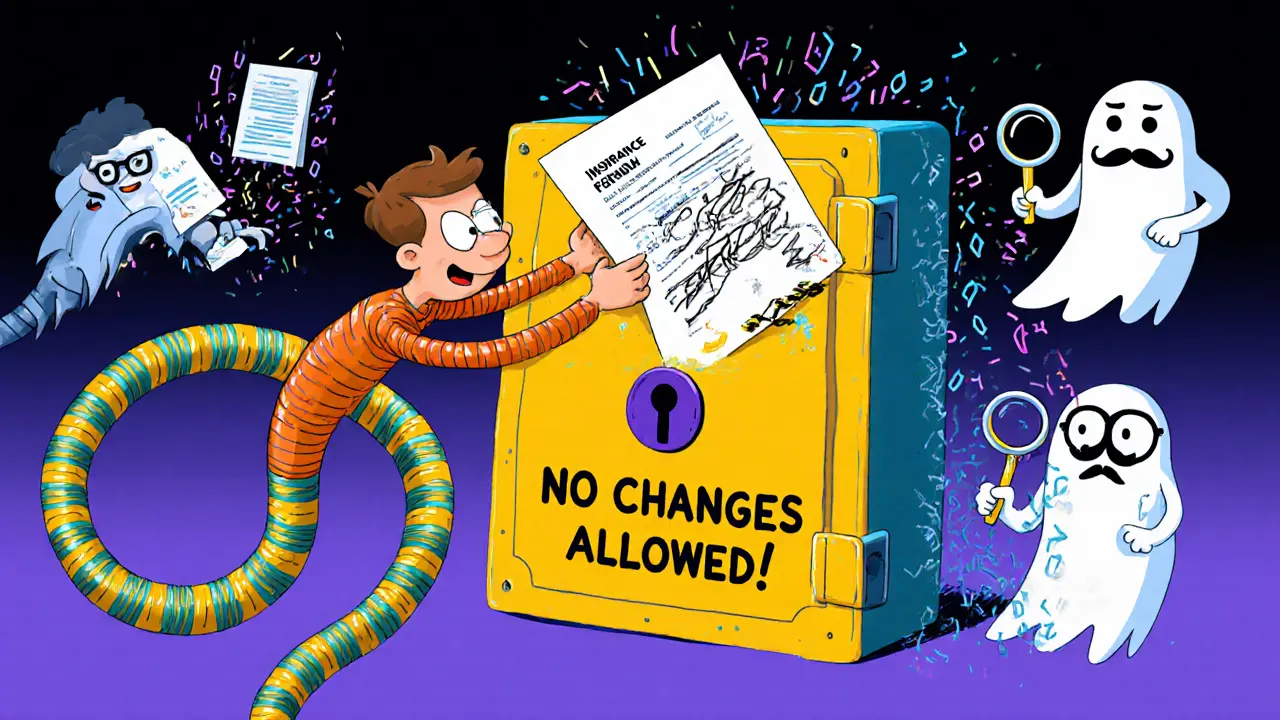Insurance Fraud Cost Calculator
Insurance fraud costs the industry over $55 billion annually in the U.S. alone. This money gets passed on to policyholders through higher premiums. See how much fraud impacts your insurance costs.
Your Fraud Cost
$0.00
Potential Premium Savings
$0.00
What this means: If blockchain technology reduces fraud by 75%, your premiums could decrease by 0%. This is because insurance fraud drives up costs for all policyholders.
Based on industry estimates: $55 billion in annual fraud costs for the U.S. insurance industry
Enter your premium and fraud percentage to see your potential savings
Insurance fraud costs the industry over $55 billion every year in the U.S. alone
That’s money pulled from policyholders’ pockets-higher premiums, slower payouts, and broken trust. For decades, insurers fought fraud with spreadsheets, manual reviews, and isolated databases. But fraudsters adapted. They filed duplicate claims across companies. They forged medical records. They used stolen identities to get life insurance payouts. Traditional systems couldn’t connect the dots. Then came blockchain.
Blockchain isn’t just about Bitcoin. It’s a shared, unchangeable digital ledger that lets multiple parties see and verify the same data in real time. In insurance, that means claims, policy details, and medical records can’t be secretly altered after they’re recorded. No more disappearing paperwork. No more ghost claims. Just one trusted version of the truth.
How blockchain stops fraud before it happens
Here’s the simple breakdown: when a claim is filed, every step gets recorded on a blockchain. The policyholder’s identity. The doctor’s diagnosis. The repair shop’s invoice. The adjuster’s approval. Each piece is hashed, time-stamped, and locked into a chain of blocks. Once added, it can’t be changed. If someone tries to submit the same medical bill twice, the system instantly flags it-because the original claim already exists on the ledger, visible to every authorized participant.
Take parametric insurance, like flight delay coverage. In the old system, you’d submit a boarding pass, wait weeks for paperwork, and hope for approval. With blockchain, smart contracts do the work. If your flight is delayed over 3 hours and the airline’s flight data (fed directly into the blockchain) confirms it, the payout triggers automatically. No forms. No delays. No room for fraud.
Companies like AXA and B3i have cut claims processing from 45 days down to under 72 hours. Fraud detection accuracy jumped 37% in Ping An’s pilot. Duplicate claims dropped by 68% in Swiss Re’s marine cargo trial. These aren’t theory tests. They’re live results.
What makes blockchain different from old-school fraud tools
Traditional fraud detection relies on rules and patterns. If someone files 5 claims in 3 months, they get flagged. But smart fraudsters know how to stay under the radar. They spread claims across insurers. They use real names with fake details. They time claims to avoid detection windows.
Blockchain changes the game by removing data silos. Before, one insurer had no way of knowing if another had already paid out on the same injury. Now, with permissioned blockchains (like Hyperledger Fabric), insurers, hospitals, repair shops, and even law enforcement can share verified data-without giving up control. Only approved parties can add or view data. Everything is traceable.
Multi-signature approvals add another layer. A claim might need sign-off from the policyholder, the doctor, the adjuster, and an independent auditor. One person can’t sneak it through. That’s impossible in legacy systems where a single adjuster has full control.

Real cases: Who’s using this and what worked
Estonia’s national health system integrated blockchain with its insurance claims in 2020. By 2023, healthcare fraud dropped 22%. Why? Because every doctor’s note, lab result, and prescription was stored on-chain. No more altered records. No more fake clinics.
In the U.S., a life insurer slashed death benefit payout time from 30 days to 72 hours by linking to verified digital death certificates on a blockchain. No more waiting for mailed paperwork. No more forged certificates.
B3i, a consortium of 40+ global insurers, reduced fraudulent marine cargo claims by 42% in 2023. How? By connecting shipping logs, customs data, and insurance claims on one network. If a shipment was never lost, the claim got denied instantly.
But not every pilot succeeded. One major U.S. auto insurer abandoned its blockchain project after 18 months. Why? It couldn’t scale beyond 5% of claims. Integration with their 20-year-old policy system was too messy. The lesson? Start small. Don’t try to replace everything at once.
The hidden problems: Why blockchain isn’t magic
Blockchain doesn’t fix bad data. If someone enters a fake injury report, the blockchain will record it perfectly-and permanently. That’s the “garbage in, garbage out” problem. It can’t tell if a claim is truthful. It just makes sure no one changes it later.
Scalability is another issue. Blockchains today handle 1,000-1,500 transactions per second. Traditional databases handle 50,000+. For a company processing millions of claims a year, that’s a bottleneck. Some insurers are working around this by using blockchains only for high-risk claims or key verification steps.
Privacy is tricky too. Medical records are sensitive. How do you prove a claim is valid without exposing a patient’s full history? New solutions like zero-knowledge proofs (ZKPs) are helping. Singapore’s 2024 pilot used ZKPs to verify a claimant’s eligibility without revealing their diagnosis. That’s the future: proving something is true without saying what it is.
And then there’s cost. Hiring a blockchain developer in the U.S. costs $130,000-$180,000 a year. Training claims staff takes 3-4 months. Implementation? 8-14 months on average. Smaller insurers can’t go it alone. That’s why many join groups like B3i to share the burden.
What’s next: AI + blockchain is the real upgrade
Blockchain alone can’t catch complex fraud networks. That’s where AI comes in. Machine learning spots patterns humans miss-like a cluster of claims from the same zip code with similar injury descriptions. But AI can be fooled if the data is manipulated.
Combine the two: blockchain ensures the data is real. AI finds the hidden fraud within it. A 2023 IEEE study showed hybrid systems hit 92% fraud detection accuracy-up from 85% for blockchain-only models. Major insurers are already testing this. Thirty-three percent are building hybrid systems in 2025.
Future trends? Tokenized policies. Peer-to-peer insurance groups. Instant payouts for weather-related damage. All built on blockchain. The market for this tech is expected to hit $1.84 billion by 2028. That’s not hype. It’s what’s already being built.

How to start if you’re in insurance
Don’t try to overhaul your whole system. Start with one high-fraud area. Parametric insurance. Identity verification. Medical claim cross-checking. Pick a use case where delays hurt customers and fraud is common.
Join a consortium. B3i, Blockchain Insurance Industry Initiative, has 1,200+ members. You don’t need to build your own blockchain. Use theirs. Share the cost. Learn from others.
Train your team. Not everyone needs to be a coder. But claims adjusters, underwriters, and compliance officers need to understand what blockchain can and can’t do. Look for courses from the Insurance Information Institute or blockchain training programs from universities like Wharton.
Start small. Prove value. Then scale.
Frequently Asked Questions
Can blockchain really prevent all insurance fraud?
No, blockchain can’t prevent all fraud. It stops fraud that relies on altering records, hiding claims, or submitting duplicates. But if someone lies on their application or creates a fake injury, blockchain will still record it accurately. That’s why it works best with AI to detect suspicious patterns and human reviewers to investigate red flags.
Is blockchain secure enough for sensitive medical data?
Yes, with the right design. Permissioned blockchains only let authorized parties access data. Zero-knowledge proofs let insurers verify claims without seeing private details-like proving you have diabetes without revealing your test results. Estonia’s system and Singapore’s 2024 pilot show this works under strict privacy rules.
How long does it take to implement blockchain in insurance?
Most enterprise implementations take 8 to 14 months. The biggest delays come from connecting to old legacy systems, not from the blockchain itself. Starting with a narrow use case-like verifying digital death certificates-can cut that time to 4-6 months.
Do small insurance companies need blockchain too?
Yes, but not alone. Small insurers can join industry consortia like B3i to share blockchain infrastructure and costs. You don’t need your own network. You just need access. Many small companies save money by reducing fraud and speeding up payouts-without building anything themselves.
Will blockchain replace claims adjusters?
No. It will change their job. Instead of chasing paper trails and calling doctors for records, adjusters will focus on investigating complex cases flagged by AI, reviewing disputes, and handling exceptions. The role shifts from data collector to fraud detective and customer advocate.
What’s the biggest barrier to adoption?
The biggest barrier isn’t technology-it’s regulation and data standards. Every state and country has different rules for digital records. Healthcare data comes in 73 different formats. Until everyone agrees on how to share data, progress will be slow. That’s why industry coalitions are critical.
Final thought: The future is shared trust
Insurance has always been built on trust. Blockchain doesn’t remove the need for trust-it makes it verifiable. When policyholders know their claims can’t be ignored or manipulated, and when insurers know they’re not being lied to, everyone wins. Lower fraud means lower premiums. Faster payouts mean happier customers. And that’s not just good tech. It’s good business.

Comments (17)
Ian Esche
November 27, 2025 AT 06:02
This blockchain stuff is just another tech buzzword to make big insurers look like they're doing something. Meanwhile, my cousin got denied a claim because some algorithm flagged his broken leg as 'suspicious pattern'. Who's really winning here?
Shelley Fischer
November 27, 2025 AT 20:04
The structural integrity of blockchain-based insurance systems is predicated upon immutable data integrity and cross-organizational consensus protocols. However, the article neglects to address the legal ambiguities surrounding digital attestations across jurisdictional boundaries, particularly in tort liability and data sovereignty regimes.
Abby cant tell ya
November 29, 2025 AT 14:46
So let me get this straight - we’re trusting a blockchain to stop fraud but not questioning if the person filing the claim is lying in the first place? LOL. That’s like putting a lock on a door that’s wide open.
Brian Bernfeld
November 30, 2025 AT 13:52
I’ve seen this play out in real life. My uncle’s medical records got stuck in a legacy system for months after his stroke. When they finally got digitized, the hospital accidentally uploaded the wrong MRI. Blockchain wouldn’t have fixed that - it would’ve just locked the mistake in forever. We need better input controls, not just better ledgers.
imoleayo adebiyi
December 1, 2025 AT 06:31
In Nigeria, we don’t even have reliable digital IDs yet. How can we talk about blockchain fraud prevention when most people can’t access basic healthcare records? This feels like building a luxury car while half the world is still walking.
Angel RYAN
December 1, 2025 AT 23:11
I like how this focuses on trust. That’s the real win here. Not the tech. Not the savings. Just knowing your claim won’t vanish into a black hole. That’s what matters to people.
stephen bullard
December 2, 2025 AT 08:40
It’s funny - we’re using a decentralized system to solve a problem created by centralized power structures. Maybe the real solution isn’t blockchain, but decentralizing authority altogether. Let policyholders hold their own data. Let them choose who sees it. That’s true empowerment.
SHASHI SHEKHAR
December 2, 2025 AT 11:57
Broooooo 🤯 blockchain + AI = next level 💯 I mean, imagine this: you crash your bike, your smart helmet auto-sends GPS + impact data to blockchain, AI cross-checks with ER records and your policy, and boom - $500 hits your wallet in 2 minutes 🚴♂️💸 No forms, no calls, no BS. This isn’t sci-fi, it’s 2025! 🇮🇳✨ #FutureIsNow
Vaibhav Jaiswal
December 4, 2025 AT 08:30
I’m just here for the part where they say ‘start small.’ Finally, someone gets it. You don’t rebuild your house by ripping out the foundation first. You fix the leaky faucet, then the drafty window. Same here.
Susan Dugan
December 6, 2025 AT 03:32
This is the kind of innovation that actually makes me proud to be in insurance. We’re not just selling policies anymore - we’re rebuilding trust. And honestly? It’s about damn time.
SARE Homes
December 7, 2025 AT 00:39
Oh wow, another ‘blockchain solves everything’ article. Let me guess - the author works for a blockchain startup and got paid in tokens. 🙄 Fraud detection accuracy jumped 37%? That’s meaningless without context. What was the baseline? Were they testing on junk data? And why no mention of the 18-month failure? Oh right - because it’s not sexy.
Grace Zelda
December 8, 2025 AT 06:02
I get why people are hyped. But let’s be real - blockchain doesn’t fix human greed. It just makes it harder to hide. The real villains aren’t the fraudsters. They’re the execs who still pay adjusters $30/hour to manually check PDFs while they spend $20M on a ‘blockchain solution’ to look innovative.
Kristi Malicsi
December 8, 2025 AT 07:14
The garbage in garbage out thing is the elephant in the room. If the data’s bad, the chain just makes it permanent. That’s not magic. That’s a digital tombstone.
Sierra Myers
December 9, 2025 AT 08:00
Everyone’s acting like blockchain is the answer. But the real question is: who gets to control the ledger? If it’s still just big insurers, we’re just replacing one monopoly with another.
Puspendu Roy Karmakar
December 9, 2025 AT 22:33
In India, we have millions of farmers with crop insurance. If blockchain can verify weather data from satellites and auto-pay when drought hits? That’s life-changing. No more corrupt agents stealing payouts. This could actually help real people.
Michael Fitzgibbon
December 11, 2025 AT 02:14
I work in claims. I’ve seen the paperwork. I’ve seen the lies. But I’ve also seen good people get crushed by slow systems. Blockchain isn’t perfect, but if it gives someone their money faster without making them beg for it? I’m all in.
Komal Choudhary
December 11, 2025 AT 05:38
Wait, so you’re saying we can now verify someone’s medical history without them having to hand over their entire life? That’s insane. How do we make sure companies don’t use that data to deny coverage later? This feels like a privacy nightmare waiting to happen.